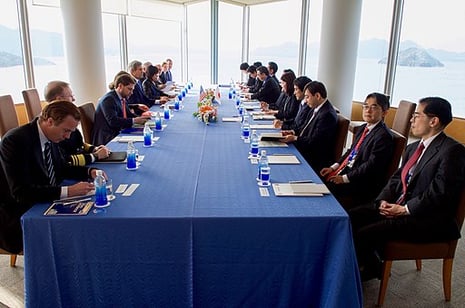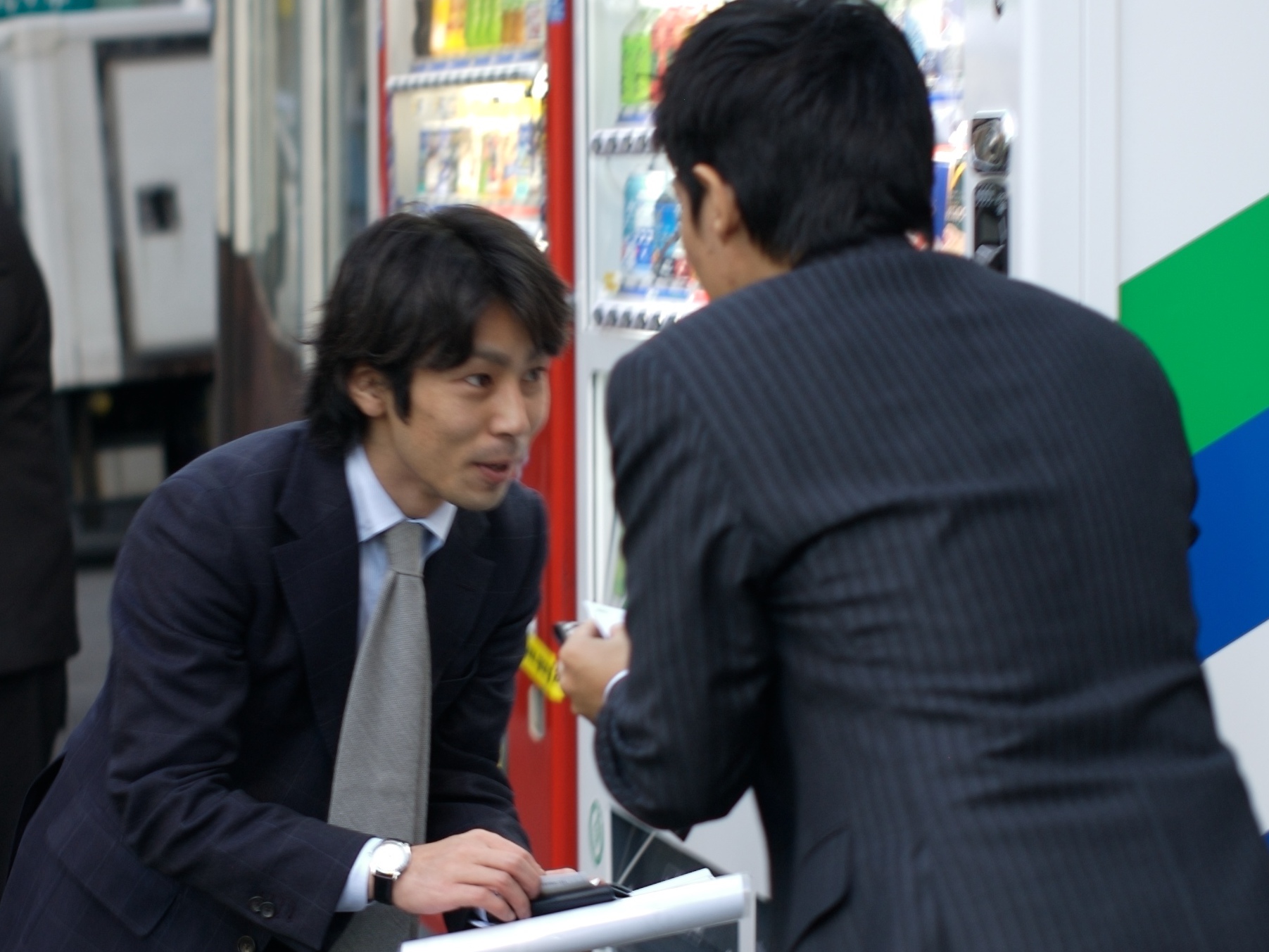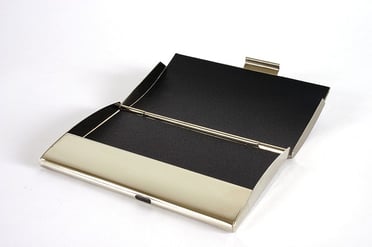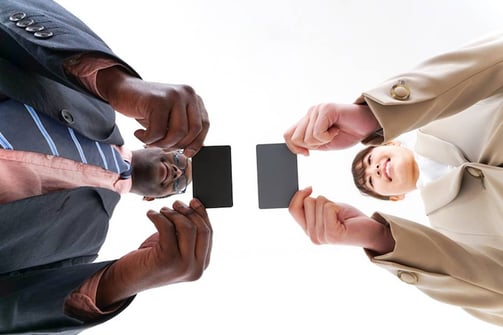Exchanging business cards in Japan is a characteristically Japanese experience. It has order, rules, and it’s easy to mess up. That’s why you’ll get a leg up if you, as a non-Japanese, master this process and sharpen your etiquette.
You probably know at least a little something about Japan’s many customs in daily life and in business. When you’re actually working on a deal with the Japanese, all of that knowledge helps, especially in business transactions, which all start with giving and receiving cards.
It’s not only part of networking, it’s part of basic communication.
This article focuses on self-study you can do, wherever you are: master the skill every successful Japanese salaryman and salarywoman knows: the meishi-koukan (business card exchange).
Exchanging these paper cards, which are the building blocks of Sansan, has a whole slate of rules in Japan, built up over centuries. Books are written about it. People take classes on it. This may sound daunting, but you’ve got two things working in your favor:
1) Being non-Japanese, there’s much less pressure on you.
2) Knowing just a little about how to conduct business in Japan the “right” way will make a great impression.
Business Cards are Supremely Symbolic
Business cards are no small matter in Japan. They have their own culture and a special symbolic value. Keep these things in mind, even if they’re different than where you come from.
- The cards represent—some say they embody—their owner.
- There are only a couple of right ways and infinite wrong ways to exchange them.
- Treating a card with disrespect can hurt your business chances. Sometimes seriously.
For the sake of your foreign relations and international trade, it’s best to sharpen your business etiquette and do things as the Japanese do, as best you can.
Pretend to be a Japanese businessperson? Yes, and No.
Making efforts to follow local practices is good manners and makes you look good. We may all use Facebook and have a Big Mac every now and then, but the world, thankfully, remains a diverse place with diverse customs.
Men kiss each other on the cheek in some Middle Eastern countries, Germans never ever jaywalk, Thais always stand at attention when the national anthem plays, and Japanese bow frequently, as you probably know.
These customs may seem awkward or nonsensical, perhaps embarrassing. But if you do them as best you can, you’ll show you care about the people and culture you’re contacting.
Do as the locals do, especially in Japan. You’ll put the other side at ease and you’ll show you care about them.
This comes back to the Japanese ritual of exchanging business cards. Moreover, your counterparts will take notice and you may find relations warming up.
Prepare for Your Meishi Exchange Before You Meet
In Japan, swapping a grubby card from a scuffed up old leather wallet can be worse than having no card at all. So before you start your exchanging, some preparation is necessary.
1. Get a good business card case/holder. The case is part of the card exchange. We’ll get to that bit later. A little dollar-shop aluminum tin, or your regular wallet, just won’t cut it. Invest at least US$30 for a holder with a touch of class. To get an idea of what the Japanese use, check the offerings on this shopping site (for example only; not an affiliate link). Our partner site Meishi Hacks also offers suggestions for attractive card cases (in Japanese).
Get a case with enough room to accommodate irregular and larger cards. European and North American cards have different standard dimensions, with North American cards being the smallest. Make sure you’ve got room for the slightly bigger Japanese cards.
|
Country |
Standard Card Dimensions |
|
United States, Canada |
88.9 mm × 50.8 mm |
|
United Kingdom, France, Germany Netherlands, Spain |
85 mm × 55 mm |
|
Japan |
91 mm × 55 mm |
|
South Korea |
90 mm × 55 mm |
| China, Singapore, Malaysia |
90 mm × 54 mm |
2. Get good-quality business cards. If your company issues you a standard card, use that if it’s an established company. If it’s a small business with lower-quality or very quirky cards, ask your boss to fund something nicer and more conventional. Direct him/her to this article if there’s any question about the value of this investment.
If you’re a consultant, solopreneur, or more creative type, you have more control. Consider putting your logo, name, address, contacts, social media accounts, and even a QR code on a Japanese-sized card, just for when you deal with Japanese. Novelty cards are fun, but you won’t win any points for creativity. Unique cards that don’t fit in a standard case or can’t be easily read may get lost and may not be scannable.
For even further localization, put your information in Japanese on the card’s back side. If you choose to do this, be absolutely sure it’s accurate. Use a qualified translator and/or professional service. Don’t DIY with Google Translate. Use the highest-quality paperboard you can afford and be sure your name and title are very clear. Get them printed and cut professionally.
3. Bring lots of cards. If you have meetings lined up, you’ll need a card for everyone who shows up, if possible. Be sure to have plenty of extras on hand. If you’re taking in a convention or conference, bring a few hundred. It’s better to be prepared in Japan than to be empty-handed.
The Rules for Business Card Exchange in Japan
Before You Even Meet your Japanese Counterparts
Find out how many people you’ll be meeting. At the meeting place before you meet anyone, take out that number of business cards and place them atop your case, with the print facing away from you. If there’s a Japanese side on your card, place that upward.
How to Do the Card Exchange
First, relax. Even Japanese can get a bit confused when figuring out who goes first. This results in a great deal of apologizing and nervous laughter, but the cards eventually get passed and business goes on.
If you’re with a Japanese counterpart, ask them what to do or just let them take the lead; that will be expected anyhow. The pressure’s more on them than you. They’re aware of what’s at stake and know how to tackle potential confusion about status.
The Proper Order
The most senior/highest-ranking people exchange cards first. Typically, the visiting part will also initiate the exchange. For example, if the sales manager and sales rep of Suzuki Superconductor are visiting the IT manager and two programmers from Kobe Computers, the sales manager will first offer a card to the IT manager. The two will mutually exchange cards. The sales manager will then work his or her way down the chain of command. Either at the same time, or after that, the sales rep will do the same, in the same order.
The Motions
Common knowledge is that business cards are given and received with two hands in Japan.
But something funny happens when two people try to do this at the same time…
It is physically impossible.
There is, of course, a right way to do it, and two hands are used only if it is a one-way card swap from cardholder to awaiting hands.
The Swap
Hold the card case, card(s) atop it, with two hands until the start of the exchange. Take your card between the thumb and index finger of your right hand. Do your best not to cover any print, such as your company logo or your name. Your counterpart will do the same.
Now comes the exchange.
Your right hand delivers the card to their left hand, and vice versa, at the same time and with a slight bow. The person in a lower-ranking may bow just a bit deeper.
Your card should go under theirs if they are in a superior position (e.g., customer, CEO, prime minister).
As you do this, maintain a smile and friendly eye contact and introduce yourself, either in Japanese (if you can) or English. If in English, state your full name and your company and give a greeting (e.g., “I’m John Smith from Ohio Steel. It’s very nice to meet you.”). If in Japanese, use your last name and your company. Your counterpart will do the same. Though it is a one-handed exchange, use your other hand to secure the card as soon as you’ve passed off your own card.
Easier said than done, right?
Watch this video (Japanese) from the 2:13 mark to see how a pro does it.
The Admiration
Accept the card atop your card holder and again be careful not to cover anything with your thumbs. Spend a few seconds examining the card. This, too, is part of the process.
Japanese will typically comment on something interesting about the person’s name, their qualifications, a detail on the card, as long as it’s respectful and conveys curiosity in the other party. If you’re asked a question, avoid giving a 5-minute response. Just say enough to keep things pleasant.
Even if this whole affair strikes you as superficial, you can probably see how it breaks the ice and stimulates conversation. This is in fact true of many Japanese formalities and stock phrases. To non-Japanese eyes and ears, they may seem repetitive and unemotional. But for Japanese people, they create harmony and an unspoken understanding. This is a quality that’s highly valued in all parts of Japanese life.
A few other business card exchange tips to keep in mind:
- Keep your cards spotless, dry, and unmarked at all times. A dog-eared or dirty card makes you look sloppy or rude. Your high-quality business card case is invaluable here.
- Stand up when exchanging cards (unless you’re not physically capable).
- Get just close enough to comfortably exchange cards, unless there is something between you, such as a table. About 1 meter is a good distance.
- Pass cards hand-to-hand. Never toss them like a blackjack dealer.
- Even if you can only remember one Japanese phrase, such as hajimemashite ("Pleasure to meet you") or yoroshiku onegai itashimasu (“I look forward to working with you”), use it without embarrassment. It shows you care and you’re making effort, and you’ll usually be praised for it.
The Procession
Now on to the next exchange. With cards swapped and everyone having met everyone else, you’ll continue to a meeting room or another place to talk.
What you need to do is keep all the cards out and atop your case and try your best to remember who’s who. If you’re in a standing situation, keep the person’s card out. Don’t put it away in your holder unless something requires use of both your hands.
The Treatment and Placement
While the exchange is done at this point, the business card now takes on a role as a signpost and a useful reminder.
In the meeting place, either keep the business card atop your holder and facing you (if there is only one person across from you), or arrange the cards on the table and facing you (corresponding to where each person is sitting). Alternatively you can arrange them in a vertical column in order of seniority. If you were given cards from people no longer there, put those in your card case.
Japanese meetings, at least at the start, are typically conducted across a table; be it in a conference room or at dinner. If documents and other things start to get in the way of the cards, only put them away if there’s no space or when the meeting is finishing up.

By U.S. Department of State from United States [Public domain], via Wikimedia Commons
In many cases, you’ll have a Japanese counterpart whose lead you can follow. However, if you’re in a totally non-Japanese and inexperienced group, or on your own, the safe thing to do is observe and copy what the other Japanese are doing.
These are the general way things go, and they’re pretty consistent from meeting to meeting. However, it’s not uncommon for someone in a position of authority to put your card away earlier or otherwise “break” a few of the rules. Don’t be offended. They’re earned it through time and seniority.
The Follow-Up, The Sansan
We’re not done yet! Any Meishi Samurai knows you don’t just stuff the cards in your briefcase and catch the next flight out of Narita.
Now it’s time to turn business cards into company assets.
When you’re back at the office, hotel room, on the plane, etc. it’s time to enter the cards into your business card scanner, content management system (CMS), and/or CRM. This will prepare you for the follow-up. If you’re using Sansan, it’s the beginning of a wonderful connection.
We’ll digitize the cards and you’ll be able to see if your new contacts have a connection with others in your company, or with other connections. You can send your follow-up mails through Sansan and keep track of your contacts as they climb the corporate ladder or if they switch to another company.
Exchanging business cards in Japan is in fact far more difficult than managing them with Sansan. If you can master both talents, you’ll be a big step ahead of your fellow foreigners.
Article by Adam Goulston, MBA, MS
Business cards are the building blocks of Sansan’s unique content management and CRM tool. Learn more about the Sansan solution for your business. Download a brochure or simply get in touch.





